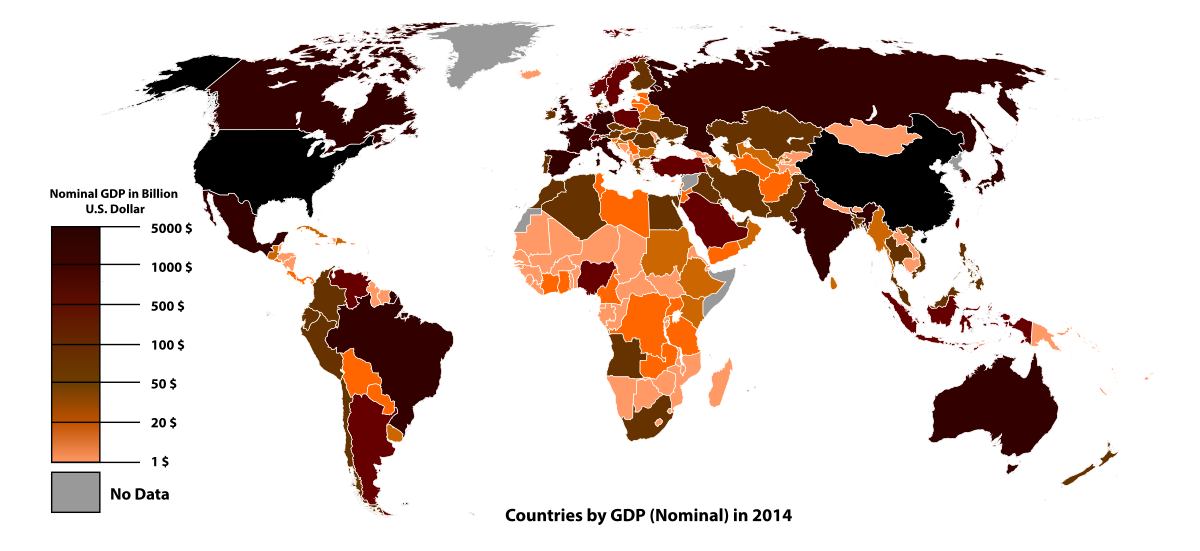The Mismeasure and Misuse of GDP

In The Great Questions of Tomorrow, David Rothkopf, an international policy expert and former editor of Foreign Policy, noted that we are on the cusp of a sweeping revolution—one that will change every facet of our lives. Klaus Schwab, the executive director and founder of the World Economic Forum, calls this development the Fourth Industrial Revolution—the emergence and convergence of artificial intelligence, synthetic biology, and smart manufacturing.
As a technology analyst, I study the adoption of emerging technologies and how individuals, businesses, and governments can best adapt to the economic disruption they create by researching trends and scenarios. But as Rothkopf points out, in order to get the right answers, we need to ask the right questions.
We should be asking whether or not societies will be better off as a result of the Fourth Industrial Revolution. To answer this question, we first need to ask several others, which include: Do we have the personnel—planners and public policy officials—in place to make the right decisions? Do the personnel have the necessary skills in order to make the right decisions? Are the effects of AI technological employment manageable or much more severe than in past industrial revolutions? And do we have the right metrics to make that determination?
The task of GDP/GNP
In the 1930s, the US Congress asked University of Pennsylvania economist Simon Kuznets to develop a uniform set of national accounts to help government officials better understand economic statistics during the Great Depression. These statistics became the prototypes of the Gross Domestic Product (GDP) and the Gross National Product (GNP), and would later earn Kuznets a Nobel Prize.
For nearly a century, economists have used a country’s GDP—the market value of the goods and services produced in a specific time period—as a metric for economic growth. GNP, on the other hand, also takes into account net income receipts from abroad and is typically used for international comparisons. The statistics underlying GDP and GNP are called the System of National Accounts (SNA). These metrics were used to stimulate growth by maximizing production and consumption of manufactured goods in the wartime economy. Today, GNP is the most widely used metric for tracking and comparing standards of living globally.
While Kuznets is often credited with the invention of GDP, the modern definition of GDP was actually developed by John Maynard Keynes during the Second World War. In 1940, while working in the UK Treasury, Keynes recognized the need for a similar set of economic statistics to estimate Britain’s production capacity with the resources available during conflict. While Kuznets’s version included private consumption and government income, Keynes also included government spending in his calculation. Keynes’s version eventually gained international acceptance and remains the standard today.
Although the GDP statistic is the most widely used metric for tracking economic growth, Kuznets realized its limitations early on. He warned that “the welfare of a nation can scarcely be inferred from measurement of national income” and that “distinctions must be kept in mind between quantity and quality of growth.” Also, while using GDP as a metric serves a purpose, it does not necessarily correlate with being better off.
Goodhart’s Law
In 1968, Robert F. Kennedy reflected on the GNP in a speech at the University of Kansas:
Our Gross National Product, now, is over $800 billion dollars a year, but that Gross National Product—if we judge the United States of America by that—that Gross National Product counts air pollution and cigarette advertising, and ambulances to clear our highways of carnage. It counts special locks for our doors and the jails for the people who break them. It counts the destruction of the redwood and the loss of our natural wonder in chaotic sprawl. It counts napalm and counts nuclear warheads and armored cars for the police to fight the riots in our cities. It counts Whitman's rifle and Speck's knife, and the television programs which glorify violence in order to sell toys to our children.
GDP and GNP are misleading metrics because they follow Goodhart’s Law, a phenomenon observed by an adviser to the Bank of England in the 1970s. The law states that as soon as an indicator is relied upon for policy decisions, it is no longer effective. For example, if shoplifting rates are used to measure crime, the police can reduce the rate of shoplifting by diverting resources from other crime-fighting activities. Shoplifting rates go down, but other crime rates go up. So, shoplifting becomes a useless indicator of overall crime trends.
The types of indicators that government bodies utilize reflect how they define progress. If a nation defines its goal as GDP, then it works towards that goal. Since the end of the Second World War almost every country has promoted GDP growth as a primary national policy goal. If governments use GDP as a performance indicator for the economy, that metric tends to improve, but at a cost to others. As a result, GDP is not as useful as it was as a measure of the broader economy and national wellbeing.
GDP measures national spending but not the effect on our wellbeing. Fighting crime and wars increase the GDP while environmental, health, and social costs do not reduce it. Legal fees, medical expenses, and defense expenditures end up on the plus side of the ledger because they create economic activity, while farmers’ markets and solar energy reduce the GDP. The cars we produce increase the GDP, but it does not account for the emissions they generate. Selling unhealthy, sugary beverages adds value to the GDP, but it fails to subtract the health problems they cause. GDP includes the value of building new cities, but does not discount for the forests and wetlands they replace.
“The BP oil spill in 2010, the largest in history, would likely register as a net gain using the GDP as the standard barometer of economic welfare,” according to J.P. Morgan analysts. But, as they point out, it actually gets worse:
When calculating the GDP, the oil spill can not only end up in the positive column because it creates economic activity, but it is actually counted positively twice: once when it’s created and again when it’s cleaned up. The economic activity generated by cleanup efforts would likely outweigh losses to tourism or fishing, while the hundreds of miles of property damage and ecosystem deterioration are not counted.
The Productivity Paradox
In the latter half of the 20th century, a third industrial revolution took place. Known as the Digital Revolution, digital electronics replaced a number of mechanical and analog electronic technologies. Robert Solow, MIT economist and 1987 Nobel Prize winner for his work on the role of innovation on economic growth, observed that you can see the computer age everywhere but in the productivity statistics. During the 1970s and ’80s, the United States experienced a slowdown in productivity growth despite rapid development in the field of information technology.
Several factors can contribute to this “productivity paradox.” The GDP metric was flawed from the outset. Unpaid work such as care-giving in the home, housework, child-care, and volunteer work are not included in the GDP because no money changes hands. Keynes pointed out that when a man marries his housekeeper, the GDP declines. The GDP also does not include the illegal transactions made by drugs dealers and sex workers.
In 1965, Gordon Moore of Intel observed that the density of components on integrated circuits in computers doubles every 18–24 months. While computers have become more productive, they also become less expensive. As a consequence of Moore’s Law, the GDP is undervalued.
A study by economists from MIT and the University of Chicago also found that the paradox between technologies and productivity occurs because many outputs are intangible which results in a mismeasurement. In the digital age, individuals give away their personal data, buying patterns, and genomic data to middlemen such as 23andMe, Amazon, Google, and Facebook. Individually the data has little value, but collectively it does. In return, social media delivers troves of information and entertainment at no cost to consumers.
In addition, one of the most significant benefits of industrial revolutions is the reduction in working hours, according to economist Joseph Schumpeter. With automation, schedules are more flexible, working conditions are better, and the number of injuries and deaths declines, but these benefits are not reflected in the GDP.
The Genuine Progress Indicator
Since social, health, and environmental factors are not represented in the GDP, alternative metrics are necessary to get a more comprehensive view and ensure informed policymaking that doesn’t exclusively prioritize economic growth. Critics of GDP argue that it not only fails to measure quality of life, in some ways it encourages practices that are not sustainable in the long-term including environmental degradation and the depletion of natural resources.
In 1995, Redefining Progress, a California think tank, developed the Genuine Progress Indicator (GPI) as an alternative to the GDP. Using 26 metrics, the GPI enables policymakers to measure how well citizens are doing based on economic, health, social, and environmental factors. A number of American states and other countries have adopted this alternative for budgeting purposes and policymaking decisions.
To compare the two indicators, researchers synthesized estimates of GPI from 1950–2003 for 17 countries which contained 53 percent of the global population and 59 percent of the global GDP. They found that the GDP had increased “more than three-fold since 1950,” while the GPI estimates that economic welfare “actually decreased since 1978.”
While the GDP is like the gross profit of a company, the GPI is its net profit, or revenue minus the costs incurred. Unlike the GDP, the GPI includes benefits for volunteer and household work and deductions for the loss of forests and wetlands. But as Tim Worstall points out, although wetlands provide buffers for storms and are habitats for life forms they are also breeding grounds for mosquitos that transmit diseases. There is a reason why we drain the swamps.
The Nordic model
Another alternative metric is the World Happiness Report. The report takes into account factors such as life expectancy, social support, freedom, trust, and generosity. According to the 2018 survey, the top four ranking countries are all Scandinavian. Finland is the happiest country in the world, followed by Norway, Denmark, and Iceland. While the US had higher GDPs per capita than the Scandinavian countries, it only ranked 18th in the report.
The so-called “Nordic model” combines free market capitalism with a comprehensive welfare state where the Nordic countries pay high taxes in comparison to other countries in the world. They have a social safety net that protects them and taxes provide free healthcare and education. Nordic people “don’t mind the tax burden as long as it directly correlates to their overall well-being.” The Nordic countries also have shorter days in the office and longer paid vacations which frees up more time to actually enjoy life. They are the happiest because they are the most secure, according to Vassili Stroganov, a Danish writer at Delfinen magazine. However, he concludes, “The real reason this model works is due to the level of trust they have placed on the system.”
Standardization and the Fourth Industrial Revolution
The Second Industrial and Digital Revolutions were, overall, beneficial to society. We are better off today because we generally live longer and are healthier and wealthier. We also have shorter working hours, fewer workplace fatalities and injuries, and more leisure time. However, these benefits are not reflected in the GDP metric. Industrialized Societies are still dealing with the externalities of these revolutions. Regulating emerging technologies, public policymakers are presented with trade-offs between international competitiveness, economic development, and the social impacts. These trade-offs are determined by a hierarchy of values.
With the trade-offs between business development, energy security, and global warming, developing and developed countries have different priorities. For AI and data analytics, China and the United States have prioritized international economic competitiveness and national security. For setting standards for data privacy, the United States has favored a hands-off approach and left the responsibility with Big Tech, while Beijing imposes its own norms on Chinese companies. Meanwhile, European governments have prioritized their citizen’s data privacy through the General Data Protection Regulation (GDPR), a legal framework that sets guidelines for the collection and processing of personal information from individuals.

At the domestic level, economists use the GDP statistic as a metric for determining interest rates and preventing inflation from spiraling out of control. For the first three quarters of 2021, the US GDP figures fluctuated between two and six percent, and in the current economic conditions, economists are eagerly awaiting the new quarterly GDP statistics to determine if we are on track for a recovery. Pandemics reduce contributions to the GDP from many sectors of the economy. However, in the age of COVID, the GDP figures are boosted by the sales of face masks and vaccines, hospital visits, and funeral costs. So, it is unclear what these figures actually mean.
Due to Goodhart’s Law and the Productivity Paradox, as we move deeper into the Fourth Industrial Revolution, the mismeasurement of the GDP will only be magnified. More efficient business practices from AI, automation, robotics, and smart manufacturing will simultaneously mean lower prices for products and services, while the cost for cybersecurity adds to the GDP. Since governments have less control over blockchain transactions, many of them will go unreported. The cost of sequencing a human genome has dropped from $3 billion to less than a $1,000, while also increasing insight into our genetic predispositions.

We embed our values into the systems used to measure what we think is important, and as a result the choice of indicators defines our goals. Following World War II, GDP was a useful metric to increase economic activity by creating jobs and income, but today the world has different priorities. As society changes, what is important also changes, and the indicators should change as well. However, unless nations share a common goal, there will be no agreement about how to measure what makes us better off.





